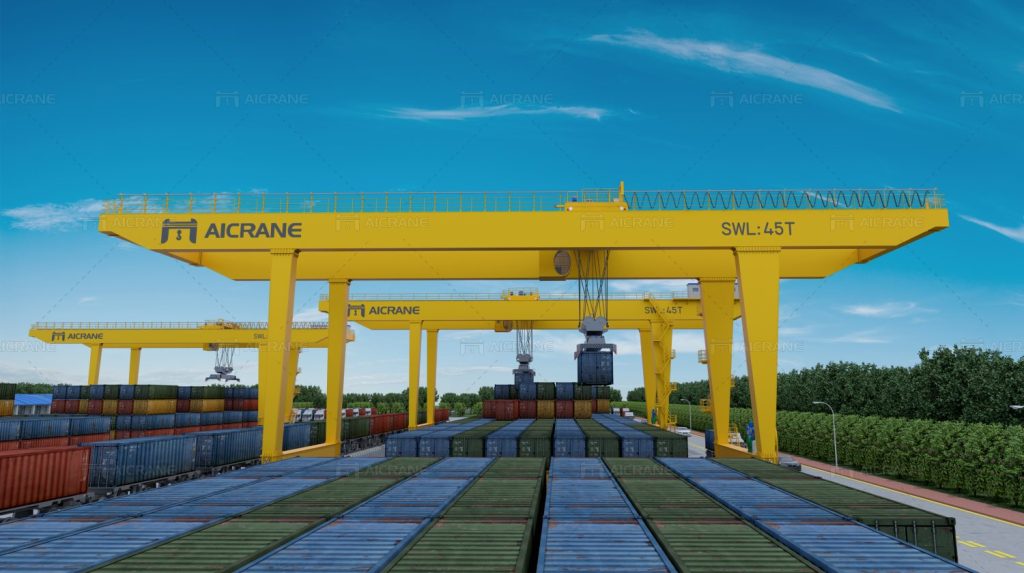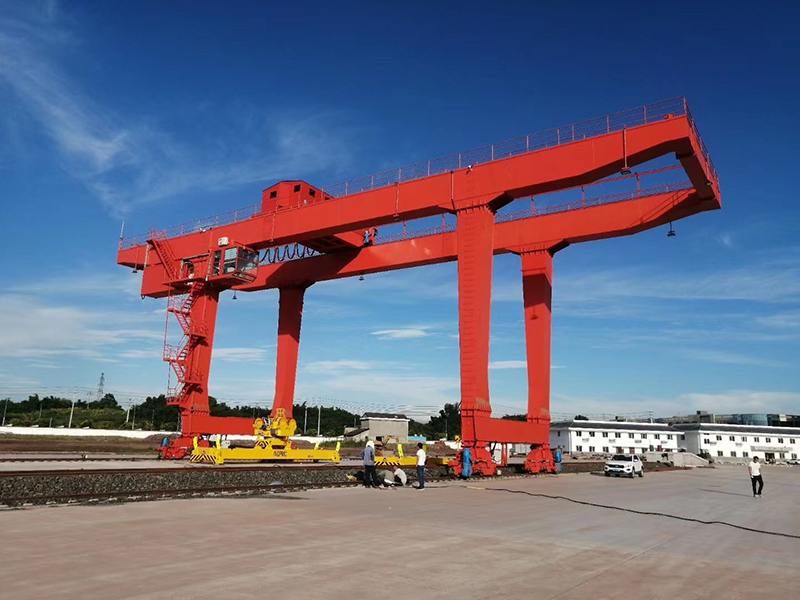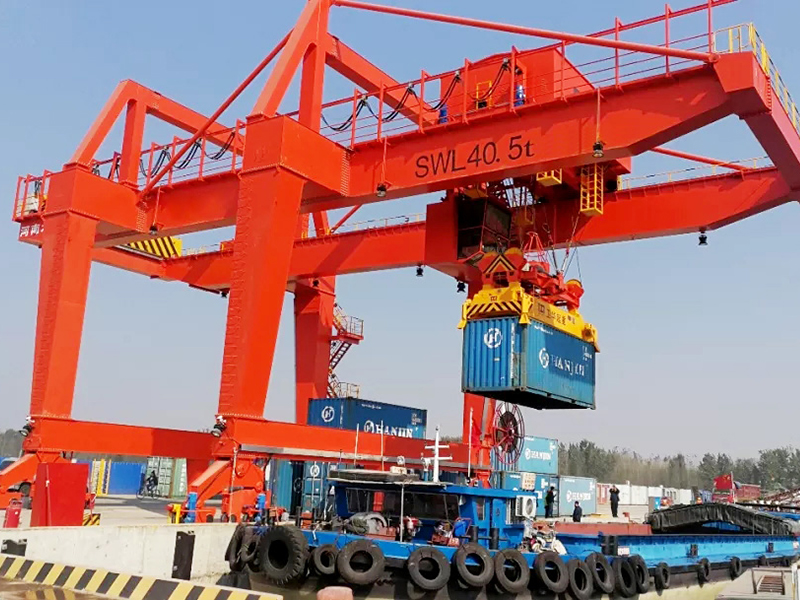A container gantry crane, also known as a rail-mounted gantry crane (RMG), is commonly used in railroad yards to handle containers efficiently. Here’s a step-by-step guide on how to use a container gantry crane in a railroad yard:
Safety Precautions
Ensure that all personnel involved are trained in operating the crane and familiar with safety protocols.
Wear appropriate personal protective equipment (PPE), including hard hats, safety vests, and steel-toed boots.
Follow all safety guidelines and regulations provided by the manufacturer and local authorities.

Crane Inspection
Perform a visual inspection of the gantry crane before operation to ensure that it is in proper working condition.
Check for any damages, loose bolts, or worn-out components that might affect its performance or safety.
Verify that the rail tracks are clear of any obstructions or debris.
Positioning
Position the gantry crane on the rail tracks in the designated area for container handling.
Ensure that the crane is aligned with the container stack or the designated loading/unloading area.
Container Loading/Unloading
Receive instructions from the yard management or control center regarding the specific containers to handle.
Use the crane’s controls to maneuver the spreader (the device that attaches to the container) over the targeted container.
Lower the spreader onto the container’s corner castings, ensuring a secure grip.Lift the container, maintaining stability and balance, and clear it from other containers or obstacles.
Move the container to the desired location, either for loading onto a train or placing it in the storage area.
Carefully lower the container to its destination, ensuring proper alignment and avoiding any collisions or accidents.
Communication
Establish clear communication channels between the crane operator and ground personnel.
Use hand signals, two-way radios, or other communication devices to relay instructions and ensure safe operations.
Maintain constant communication during the entire process, especially when working in congested areas or with limited visibility.
Documentation and Record-keeping
Keep accurate records of container movements, including arrival, departure, and storage locations.
Document any incidents, damages, or abnormalities that occur during the crane operations.
Follow the established reporting procedures for any safety concerns or equipment malfunctions.

Post-Operation
Conduct a post-operation inspection to check the crane for any signs of damage or malfunction.
Securely park the gantry crane in the designated area after use.
Follow proper shutdown procedures, such as turning off power, locking controls, and securing the crane.
Remember, this guide provides a general overview of how to use a container gantry crane in a railroad yard. Always refer to the manufacturer’s specific instructions and guidelines for the particular crane model you are operating, as procedures may vary.
Maintenance of container gantry crane
Maintenance is crucial for ensuring the safe and efficient operation of a container gantry crane. Regular maintenance helps to identify and address potential issues before they escalate, reduces downtime, and extends the lifespan of the crane. Here are some key aspects of maintaining a container gantry crane:
Establish a Maintenance Schedule: Create a maintenance schedule that includes routine inspections, preventive maintenance tasks, and periodic servicing. The schedule should be based on the manufacturer’s recommendations and take into account the crane’s usage, environmental conditions, and other factors.
Visual Inspections: Conduct regular visual inspections of the gantry crane to identify any visible signs of wear, damage, or misalignment. Check for loose bolts, damaged cables or wires, worn-out components, and any leaks. Inspect the gantry structure, boom, spreader, hoist system, trolley system, and electrical components.
Lubrication: Proper lubrication of moving parts is essential to minimize friction, reduce wear, and ensure smooth operation. Follow the manufacturer’s guidelines regarding the type of lubricants, intervals, and quantities required for different components. Pay special attention to the hoist system, trolley wheels, sheaves, bearings, and any other moving parts.

Electrical System Maintenance: Inspect the electrical components, including cables, connections, control panels, and switches, to ensure they are in good condition. Check for any signs of overheating, corrosion, or loose connections. Perform electrical testing and calibration as recommended by the manufacturer.
Structural Integrity: Regularly inspect the gantry structure, rails, and supports for any signs of corrosion, cracks, or deformation. Pay attention to welds, bolts, and other connections. Any structural issues should be addressed promptly to maintain the crane’s stability and safety.
Rope/Cable Inspection: Check the wire ropes or cables used in the hoist system for signs of wear, damage, or distortion. Look for broken strands, corrosion, flattening, or kinks. Follow the manufacturer’s guidelines for inspecting, replacing, and maintaining wire ropes or cables to ensure safe lifting operations.
Safety Device Inspection: Verify the proper functioning of safety devices, such as limit switches, emergency stop buttons, overload protection systems, and anti-collision systems. Test these devices regularly to ensure they activate correctly and meet safety requirements.
Operator Training: Provide proper training to crane operators on maintenance procedures, including daily checks, lubrication, and reporting any abnormalities. Encourage operators to report any observed issues promptly for further investigation and resolution.
Documentation: Maintain comprehensive records of maintenance activities, inspections, repairs, and parts replacement. These records help track the maintenance history of the crane, identify recurring issues, and ensure compliance with maintenance schedules.
Professional Assistance: Engage qualified personnel or authorized service providers for major inspections, complex repairs, and specialized maintenance tasks. They have the expertise, tools, and resources to conduct in-depth inspections, troubleshooting, and repairs.
Remember, the specific maintenance requirements may vary depending on the crane’s model, manufacturer guidelines, and local regulations. Consult the crane’s operation and maintenance manual, and follow the recommended practices to ensure the safe and reliable operation of the container gantry crane. For more details of crane solutions, you can visit this website as you need https://www.ellsencranes.com/.
